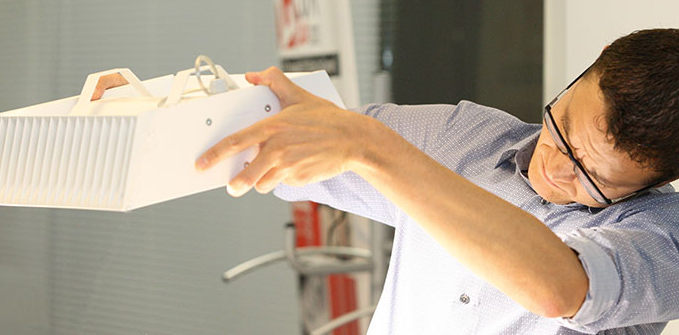CAT | LED downlights
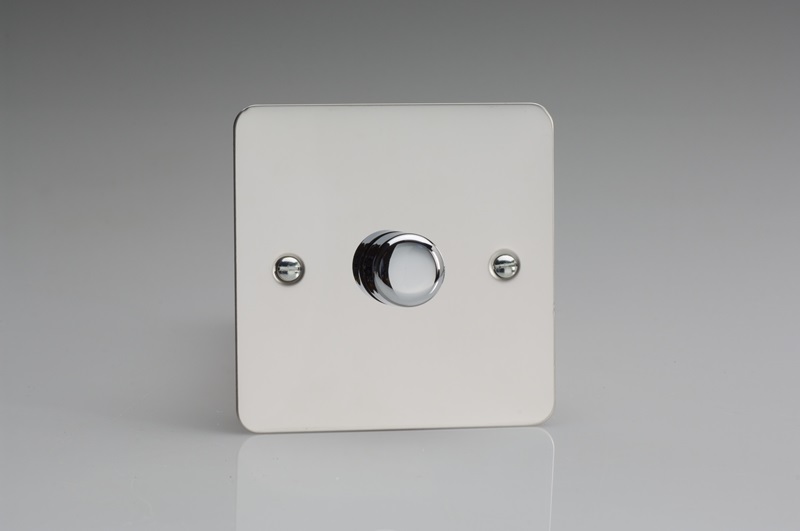
John Doyle, Managing Director of Doyle & Tratt Products Ltd, British manufacturer of the Varilight brand of dimmer switches, explains further why contractors no longer need to accept second-best, particularly in relation to the dimming of LED lamps.
With an ever-increasing array of new control technologies available and many style and colour options for clients to choose from, electrical contractors rely heavily on good product availability from wholesalers across a very wide range of wiring accessories. You cannot always rely on the products you need being available ex-stock. Therefore, if a wholesaler is not offering same-day or next-day availability on a full range they are likely to miss out on orders and risk losing your support.
Further, if the product most suited to an intended application is not readily available there is also a danger that you will purchase a generic item off-the-shelf instead, especially at the final fix phase when time is of the essence. Inevitably, this often leads to problems down the line when products fail to perform satisfactorily or fail prematurely, requiring a re-visit to the site to troubleshoot or replace the originally installed item. This is costly in terms of your time and also your reputation. With your own credibility at stake, you want to install the best solution first time around and not settle for second best.
Don’t settle
Take the increasingly common example of a client asking their electrician to install energy-efficient LED lighting. Through (sometimes bitter) experience, most electrical contractors will have settled on a preferred brand of lamp, and, if the customer is looking for dimmable lighting, a preferred brand of dimmer as well. Unsurprisingly, all LED lighting is not created equal, even if it is described as “dimmable”, and so it is important to select the best dimmer switches for the job in hand. There are many dimmer switch technologies now available but very few deliver consistent results so it’s important for the electrician to have quick and easy access to the best dimmer for the application to avoid significant delay and client dissatisfaction.
“Unsurprisingly, all LED lighting is not created equal, even if it is described as ‘dimmable’, and so it is important to select the best dimmer switches for the job in hand.”
Many leading manufacturers have established supply chains that enable next-day delivery of items not generally available on wholesalers’ shelves. Therefore, you should always ask specifically for and insist on receiving the product you know is best suited to the job.
This is particularly important when new technologies arrive because it is difficult for wholesalers to indentify whether a new product should become a stock item. For example, when Varilight’s V-Pro series LED dimmers were first launched it took a while for wholesalers to begin stocking them. The V-Pro dimmer is now our best-selling product and widely available ex-stock. Meanwhile, our new V-Com series dimmers for larger LED loads are new to the market and not yet widely stocked. However, as with all Varilight products they are available on a next-day basis through our well established supply chain.
Ready to go
For contractors, the knowledge that a product is available next-day from your preferred wholesaler enables you to confidently recommend the products you know will be the best ones for your client’s application. Ready stock availability streamlines your business with reduced downtime and site re-visits while enabling you to deliver the optimum solution for the client.
Additionally, in situations where two manufacturers’ products are being used in an application, as in the above case with LED lamps and dimmer compatibility, knowledge is especially important. Many lamp manufacturers have tested their lamps with a range of dimmer switches and list them on their websites. Additionally, dimmer manufacturers may be able to recommend lamps that they know from experience give excellent results every time.
Quite clearly, it is no longer sufficient for manufacturers to have great products; investment is required to develop robust and well-structured supply chains to ensure those products are readily available for contractors to procure on a next-day basis.
You, as contractors, have a vital role to play in this process. It is only by insisting that your preferred wholesaler stocks or can quickly obtain products you know and trust, that they will have them available when you need them. In this way, you are able to respond at short notice and you can increase your credibility with your clients.
Visit www.novelenergylighting.com today to explore our range of Varilight dimmers and LED lighting. Call us 0208-540-8287 which questions, or email us: sales@novelenergylighting.com
led dimmers · led dimming · Novel Energy Lighting · varilight · varilight dimmers

State-of-the-art LED lighting brings new life to The Lowry’s high-profile auditoriums. The major upgrade shows Dextra Lighting’s edge over competitors by offering the theatre venue both quality and modern functionality, without compromising on affordability.
About the Project
The Lowry is the fruit of decades of continuous efforts to regenerate the local docklands. The magnificent architectural landmark is more than just an arts centre, it is a bustling tourist destination, attracting hundreds of thousands of visitors every year to the Greater Manchester region. Since opening in April 2000, the flagship building has been raising the cultural profile of the North West and boosting the regional economy. The centre now offers a number of facilities including two high-profile theatre halls – the Lyric, with a capacity of 1,730 and the Quays theatre, offering up to 430 seats.
The complex is situated in the heart of Salford’s thriving MediaCityUK; a creative hub for the digital and media industries. In 2007, the BBC relocated five of its major departments from London and its existing Manchester offices to the redeveloped Salford Quays, using The Lowry’s theatres and studio spaces for a number of productions and events.
Launched as a National Millennium project, The Lowry has been financed through British and European public sector programmes and patrons from the private sector. As a cultural attraction of national and regional importance, the project’s procurement and design process have always been to the highest standards, with periodic renovations aimed at improving the financial and environmental sustainability of the building. With this in mind, Dextra Lighting were approached by AA Projects’ experienced team of low carbon consultants, to provide a modern lighting solution balancing quality with cost-effectiveness, using its vast range of precision-engineered LED luminaires to enhance the theatre’s facilities.
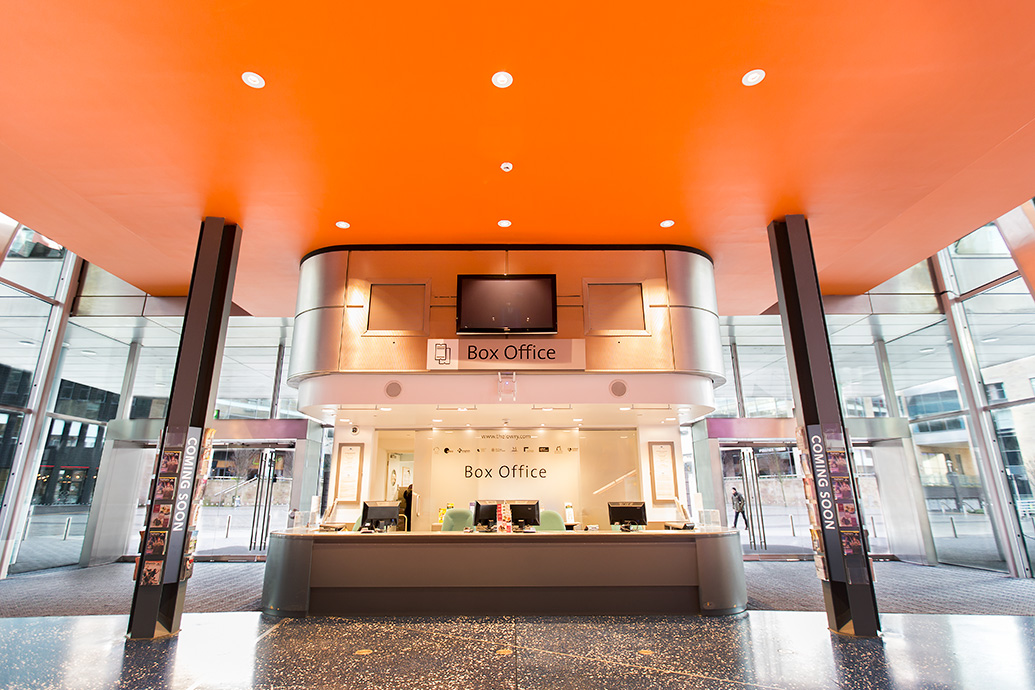
The brief
The lighting upgrade targeted both the main auditoriums and backstage areas. The theatre’s existing lighting needed to be replaced with cutting-edge LED alternatives, offering today’s standards of energy-efficiency and flexible controls, whilst creating a suggestive atmosphere for theatre-goers. For the back-of-house areas, energy-saving, low-maintenance lighting was required abiding by all health and safety regulations. Dimmable front-of-house lighting was required to allow The Lowry’s technicians to easily and accurately dim the lights from the audio-visual control rooms. Overall, the LED upgrade’s aim was to save The Lowry more money on the installation through reducing electrical consumption, installation and maintenance costs.”Pro-light Mini – The Lowry saved money on installation with this product, as prewired leads and simple retractive spring clips helped minimise fitting times”
The products
Theatre Main Lighting – Protec LED
The highly popular Protec LED downlight was supplied in a range of lumen outputs to act as primary lighting for both the theatre halls. Using the latest Lumileds LEDs and efficient anodised aluminium reflectors, the luminaire offers impressive energy savings with short payback periods over fluorescent equivalents. The combination of high-quality LED sources and advanced optics allow the Protec LED to offer LORs in excess of 90% in lumen outputs of up to 3000lm to allow The Lowry to comfortably meet its energy targets whilst giving designers the flexibility to tailor the installations to suit the hall’s architectural design.
The Protec LED’s appealing contemporary construction is ideal for high-end specifications and can be customised with a wide selection of options including,
interchangeable reflectors and colour attachments, and custom bezels (for retrofit applications), to suit a host of interiors and adapt to future changes in decor.
From a range of dimming options, the luminaire was supplied with High-Frequency dimming drivers and was commissioned to give AV technicians full access from the halls’ control rooms.
The Protec LED is also designed to offer flexible and cost-effective installation, with a four-point, self-clamping bracket making the job quicker and easier for appointed electrical installers, AMEON Ltd, whilst being suitable for plaster, mineral fibre and metal tile in thicknesses between 3mm and 30mm.
Accent Lighting, Front of House & Box Office – Pro-Light Mini
The Pro-Light Mini high-quality LED spotlight was chosen to replace the existing accent lighting for the theatre hall, to safely guide patrons to their seats and add to the inviting atmosphere. The spotlights also helped welcome theatre-goers to the theatre with a controlled and elegant lighting effect. The luminaire is a highly-efficient replacement for fluorescent equivalents, offering the durability, reliability and energy-efficiency of the latest Tridonic COB modules combined with advanced aluminium faceted reflectors, to cut The Lowry’s electricity bills and maintenance costs (e.g., avoiding frequent lamp changes) whilst offering premium performance.
Like the Protec LED, versatility and quality define this range. Offering a number of body styles (Fixed, Gimbal, Wallwash and Scoop), coloured bezels, three beam angles and a range of replaceable twist-lock reflectors, the luminaire can be fashioned to suit the aesthetic and practical needs of a host applications whilst offering flexibility to adjust to changes to the interior. The
luminaire is also available in colour temperatures of 3000k or 4000k in a colour rendering index of 80+.
For the theatre halls and box-office, the Pro-Light Mini was provided in a round Fixed body, providing an unobtrusive yet elegant look. The luminaire was angled at 40°, with an efficient specular reflector to direct the lighting in key areas. Centralised High-Frequency dimming controls and integrated 3 hour maintained emergency functions were also provided as per The Lowry’s specific safety and technical requirements.
The Lowry saved money on installation with this product, as prewired leads and simple retractive spring clips helped minimise fitting times. Dextra Lighting also supplied made-to-measure infill rings for both the Pro-Light Mini and Protec LED to assist with installation into the ceiling’s existing cut-outs.
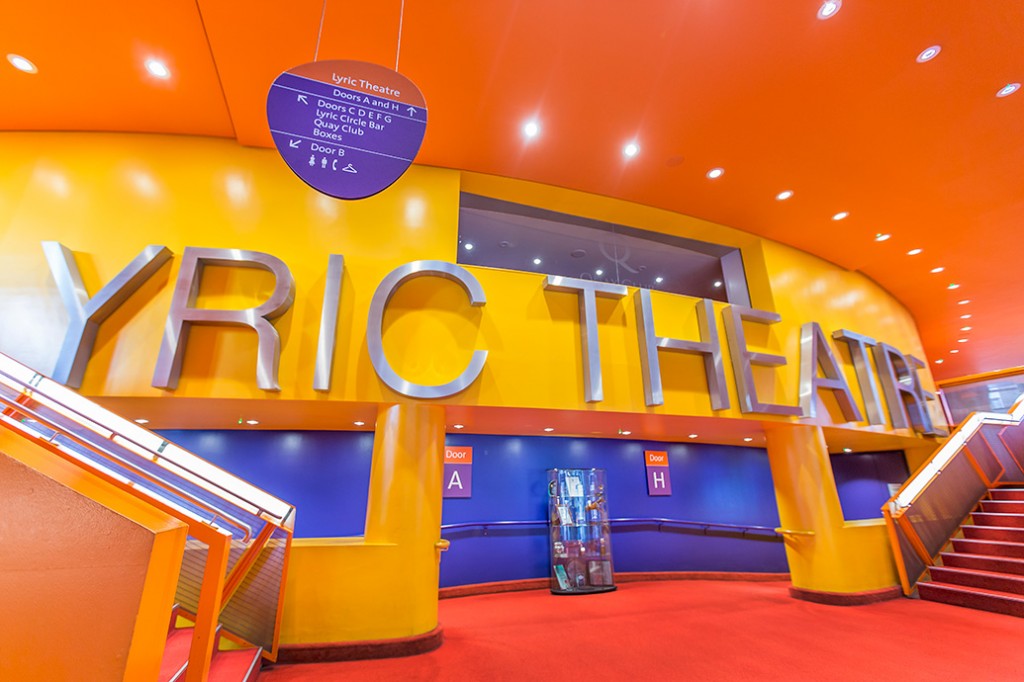
Dressing Rooms & BOH – AMED LED & Hydra LED
Although BOH areas are often neglected in lighting designs, huge savings can be made by simply upgrading to high-efficiency, low-maintenance LED luminaires, helping improve returns on investment further. The Amenity Decorative LED bulkhead not only lowered energy consumption by approximately 60% compared to the existing lighting without compromising on performance; it also added an appealing decorative touch to the performer’s dressing rooms. Available in a number of options including lumen outputs of up to 3000lm, a range of integral sensor and dimming controls to maximise energy savings, and self-test or auto-test 3-hour maintained emergency functions, the luminaire comfortably fulfilled The Lowry’s practical and safety requirements whilst tying in with its sustainability goals.
The IP65-rated Hydra LED offered an efficient, hassle-free, low-maintenance solution for the remaining back-of-house, such as store rooms and back stage
circulation areas. Available in of lumen outputs ranging from 2200lm to as high as 12,600lm across 4 body sizes, with LORs of over 90%, the luminaire combines flexibility and efficiency in a practical and affordable package. A number of dimming options (High-Frequency, Switch, DALI, DSI and Corridor Mode) and emergency functions are also available with this range to suit a host of applications. The durable luminaire also offers protection to dirt and dust ingress, water and light impact, as well as resistance to temperatures between -20℃ and +25℃. The Hydra LED is also designed to offer tooled access in compliance to current regulations .
Upon special request, all LED products were provided in a warmer C83 colour temperature to suit The Lowry’s desired aesthetic and were offered with Dextra Group’s comprehensive 5-year warranty for additional peace of mind.
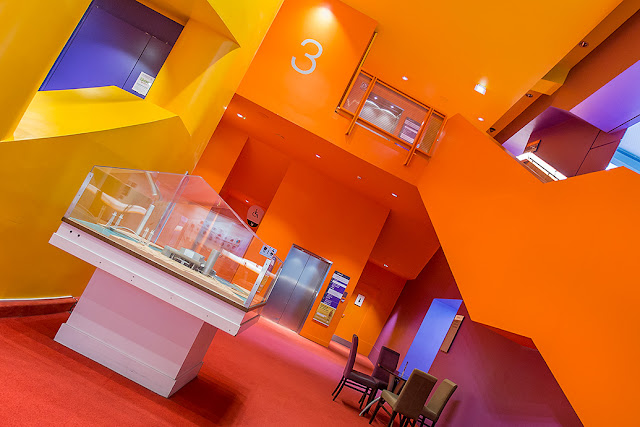
Visit www.novelenergylighting.com today to explore LED options for your project retrofit. We can supply Dextra, Philips, Thorn, and other major lighting brands, and support with site surveys and lighting designs. We can assist with project funding using energy efficiency financing. Call us: 0208-540-8287, or email us: sales@novelenergylighting.com today to start the discussion!
dextra led · LED downlights · led floods · led lighting · LED spots · led wall wash · lighting retrofits · museum lighting · Novel Energy Lighting · theatre lighting
Selling Cars the Megaman Way:
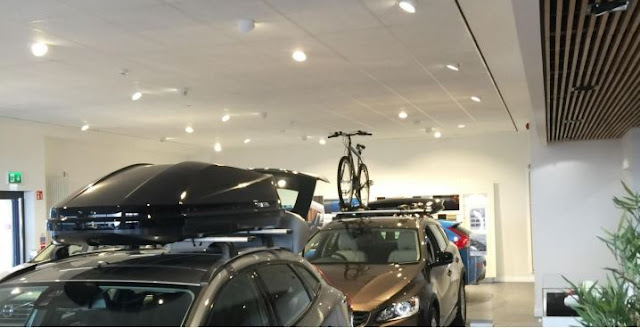
When Greers of Antrim wanted lighting that would not only show the cars off to the best effect but also provide massive energy savings, they decided on various Megaman lamps for the refurbishment. Greers, a family business and the only independent authorised Volvo Dealership in Northern Ireland, needed more space and decided to merge two buildings together to make one big showroom. Megaman’s technical team worked out the best way to achieve perfect illumination on the cars, achieving the maximum financial and energy savings, whilst reducing future maintenance. T & E Howie carried out the installation.
Megaman’s Carlo was specified for the main showroom over the cars utilising a 39W Tecoh RDx LED module in the fitting. Carlo is a range of recessed adjustable scoop LED downlights that offer excellent lighting performance and can be used to replace metal halide fittings. Adjustable up to 45° tilting angle and 355° rotation angle, the Carlo is an
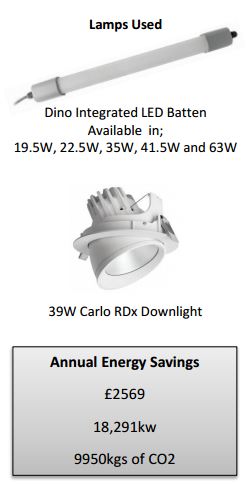
ultra-flexible energy saving solution for use in retail applications where the merchandise has to catch the eye.
Megaman’s 15W AR111’s were chosen for the wooden ceiling in the ‘customer welcome area’ to provide a relaxed and welcoming atmosphere. The 2800K colour temperature of the AR111’s produces a comfortable warm, white light and the narrow beam angle make it perfect for installation in display and furniture applications. UV resistant and corrosion-proof Dino LED battens have been used in the service and inspection bays to provide a high performance illumination. The IP66 rating ensures protection against water and dust ingress and a tough polycarbonate body with a prismatic diffuser.
The Siena integrated LED downlighters have been incorporated in toilets and small store rooms. Compact in size and with no external driver, these downlighters are easy to install and maintain whilst delivering high efficiency and lumen output. Ultra slim 50W Berto panels have also been installed in the offices to provide an integrated lighting solution that facilitates easy installation and maintenance. It delivers a high luminous efficacy up to 109lm/W – matching the lighting levels of 3 x 18W T8 and 3 x 24W HE T5 fluorescent modular fittings.
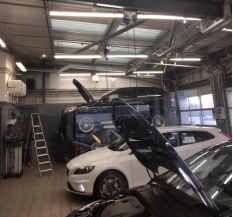
The lighting refurbishment has resulted in a saving of £2569 pa when compared to traditional lamps and, perhaps more importantly, reduced energy consumption by 18,291kw a year and 9950kgs of CO2. Paul Howie, from the installers T & E Howie, commented “We are delighted to have been nominated to do the work for Greers and are very pleased with the finished work on the project. I hope that it helps Greers to continue their success in selling cars whilst keeping lighting bills to a minimum”
Visit www.novelenergylighting.com to explore Megaman LED options for your retrofit project. Call us today to discuss pricing and availability: 0208-540-8287, or email: sales@novelenergylighting.com
led downlight · led ip66 · megaman dino · Megaman LED · megaman led ar111 · megaman lighting · megaman siena · Novel Energy Lighting
GE to deliver energy savings of more than 50% and cut greenhouse gas emissions by more than 7,000 tonnes annually with Santander lighting infrastructure upgrade
Demonstrating that corporations no longer have to choose between ‘profit and planet’, GE has delivered a cash-positive lighting infrastructure upgrade for the UK business of global banking institution Santander.

Lux reports: As the UK’s biggest ever fully-funded LED lighting retrofit, the project will see 90,000 new lights installed across the bank’s UK estate of 800 branches and 13 office buildings – slashing energy use in half and reducing carbon emissions by more than 7,000 tonnes each year.
Providing a full scope solution, GE will deliver lighting services throughout the 10-year contract, which includes optimised system design, installation, maintenance and management.
Importantly, the project is to be delivered using a cash-positive financing model, in a move that is set to reinvent the way people (companies?) think about investment in energy efficient lighting upgrades. The model includes a substantial investment of £17.5 million by the UK Green Investment Bank plc and Sustainable Development Capital Limited, making it the biggest LED-financing package the UK has ever seen.
This unconventional approach, in which the financing partners enable the lighting to be procured as a service rather than a product purchase, allows Santander to benefit from the reduced operating costs and improved energy efficiency of the LED lighting but without the capital investment and impact on the balance sheet – a flexible solution that could pave the way for many other organisations to follow suit.
Dan Vinton, CFO GE Lighting EMEA at , commented: “The lighting industry has changed dramatically in the last few years, moving away from supplying product as a simple disposable commodity, to providing high value solutions to customers while becoming a true energy efficiency partner. The old models of the lighting industry are no longer fit for purpose in this new market and this project represents a glimpse into the new world.”
“More than anything, this project has been about listening to our customer’s needs and working with them to develop a tailored package of lighting and finance solutions that perfectly meet their requirements. The strength, credibility and expertise represented by the GE brand helped make the project bankable which was a key element of success. We’re privileged to have been able to walk this learning journey together with our partners and proud of what we have accomplished here. We are now focused on scaling this offering more broadly and allowing more customers in our target markets and verticals to benefit from this type of smart value creation.”
Nick Roberts, Property Director, at Santander, said: “We launched our 20-20-15 energy efficiency strategy three years ago, in which we committed to reducing energy consumption and CO2 emissions by 20 per cent by 2015. LED lighting has become an integral part of our Energy Efficiency Plan and plays a key role in achieving these overall sustainability goals. Through this lighting upgrade we have taken a huge step forward in executing our long-term efficiency objectives, with GE providing the support, scale and suitable products that we needed.”
Visit www.novelenergylighting.com today to explore what LED can do for you. Distributors for all major brands, including GE LED. Call today for project pricing and financing details: 0208-540-8287, or email: sales@novelenergylighting.com
ge led · ge lighting · LED lamps · led lighting · led panels · led tubes · lighting project finance · lux · Novel Energy Lighting · santander led retrofit
The first LED PL-C lamp designed to save energy and downsize costs

CorePro LED PL-C is the first PL-C lamp replacement for downlighters that provides up to 60% energy saving, three times longer lifetime (30,000 hours) and a robust, shatterproof plastic housing. A retrofit lamp that’s simple to install, fits fixtures with E.Mag or HF ballast and requires less maintenance and servicing. So you can downsize your downlighting costs with energy efficient LED.

Application areas:
Focus on general circulation areas in downlight luminaires as key applications


Saving energy without compromising on light quality:
• CorePro LED PL-C lamps save >50% energy by directing the light so that none is wasted above the luminaire.
• Therefore the CorePro LED PL-C lamp also requires less light (lumen) to reach the same lux levels.
• In addition, the rotating end-cap feature ensures lamps can always be rotated in the ideal direction.
• The rotating functionality (from -45˚ to +90˚) offers the possibility to optimise light distribution and fit of the lamps, whatever type of luminaire they are being installed in.
Range build-up

Compatible with all Electro Magnetic ballasts
• Recognisable by 2 connector pins on socket base
• Available in two socket types:
– G24d-2 to replace 18W / G24d-3
– to replace 26W conventional PL-C lamps.
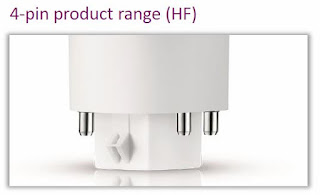
Compatible with Electronic / HighFrequency ballast
• Recognisable by 4 connector pins on socket base
• Available in two socket types:
– G24q-2 to replace 18W
– G24q-3 to replace 26W conventional PL-C lamps.
Key benefits
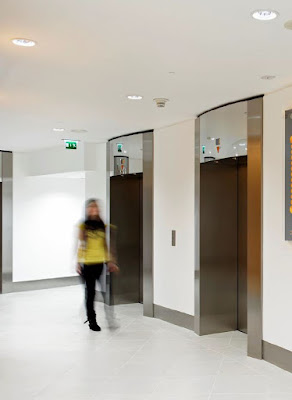 Energy efficient
Energy efficient
• More than 60% more efficient compared to fluorescent PL-C lamps, saving on energy costs
Long lasting & robust
• With lifetimes up to 30,000 hours (vs. 10,000 hours Fluorescent PL-C), reducing maintenance costs
• PL-C LED Lamps are made of shatter-proof plastic instead of glass
Simple lamp for lamp replacement
• Easy upgrade from current conventional downlight fixture to LED PL-C (hassle free)
• Re-using the existing fixture without major modifications, using a similar PL-C form-factor
High quality of light
• No flickering or stroboscopic light
• Instant 100% light
Product specifications
Philips CorePro LED PL-C 2-pin range:
• Two wattage positions for G24d-2 and G24d-3 socket holders
• 3000 K & 4000 K
• Efficiency up to 112 Lumens / Watt
• < 2 years pay-back, at affordable initial price point
• Rotating end-caps, to rotate light in the ideal direction
• Perfect fit dimensions, to enable optimal fit with existing luminaires
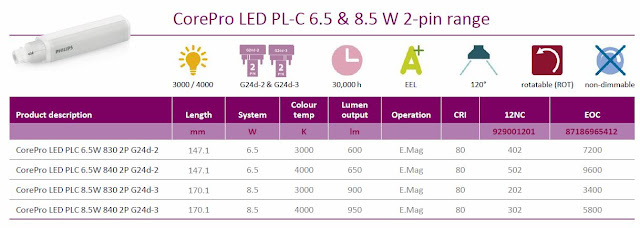
Philips CorePro LED PL-C 4-pin range:
• Two wattage positions for G24q-2 and G24q-3 socket holders
• 3000 K & 4000 K
• Efficiency up to 100 Lumens / Watt
• < 2 years pay-back, at affordable initial price point
• Rotating end-caps, to rotate light in the ideal direction
• Perfect fit dimensions, to enable optimal fit with existing luminaires
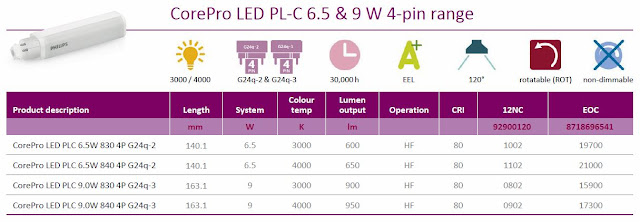
Visit www.novelenergylighting.com to browse the selection of Philips Corepro PL-C lamps today, or call us for volume pricing, tel: 0208-540-8287
led g24d · led g24q · led lighting · led plc · Novel Energy Lighting · philips corepro led · philips corepro plc · philips led
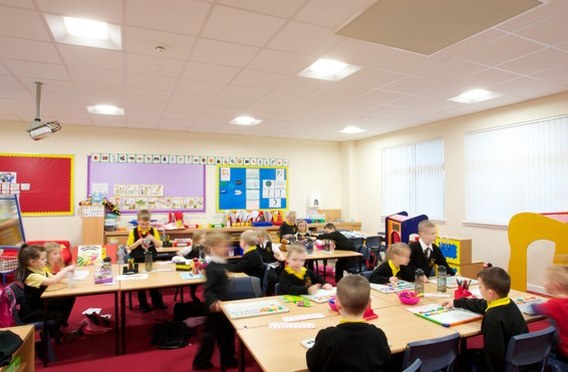
Education is no longer about teaching; it is about creating a stimulating learning environment. Or to put it another way the quantity of information given out by a teacher is less important than the amount of information taken in by a student. This shift in emphasis has impacted the design of education buildings. Previously they were designed around the needs of the teacher whereas they are increasingly designed around the needs of the student. This requires more flexible spaces suitable for formal teacher led sessions and also for less formal group discussions and breakout sessions.
Building design has also developed as the importance of daylight to learning rates and attendance levels has begun to be understood. Therefore modern learning spaces tend to receive significant levels of daylight which in turn leads to significant energy savings in well-designed lighting installations.
Best practice
The European Standard EN 12464-1:2011 Light and lighting – Lighting of work places Part 1: Indoor work places provides recommended lighting levels for academic buildings. However whilst important these recommendations address only a part of the lighting requirements. Education is a communication centred discipline and lighting of people so they appear friendly and so that body language is readily visible is important, as is facilitating the use of all presentation materials and formats. EN 12464-1:2011 also provides recommendations for cylindrical illuminance to ensure good lighting of verticals, 150lx at 1.2m height. It discusses the modelling index, the ratio between the horizontal and vertical flow of light, to provide the correct balance between light and shade. It also highlights the importance of lighting room surfaces to make a space feel light and airy and prevent a sensation of gloom, recommending an average illuminance of 75lx on the walls and 50lx on the ceiling.
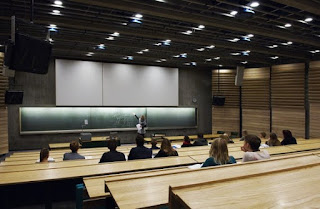
Education should always be centred on the needs of people and care should be taken not to design spaces for technology at the expense of comfort. However in some areas of high DSE use care should be taken to take account of the effect of lighting on screens. Recommendations for lighting for DSE are provided in the European Standard EN 12464-1:2011 Light and lighting – Lighting of work places Part 1: Indoor work places. However these criteria are for general computer technology and if plasma screen technology is used tighter control of luminaire brightness should be considered. Ideally the balance between lighting for people and lighting for technology should be achieved by intelligent use of lighting controls and scene setting to allow lighting to be adjusted to the needs of the moment.
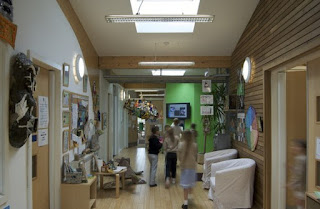
Taking control
Supplying comfortable and effective light is not the same as supplying controlled and energy-efficient light. A lighting system should interact with the space, dimming in response to increasing levels of daylight, turning on or off in response to occupancy within the space, and with increasing use of technology and the need for flexibility of learning styles allow lighting scenes to be set to provide the optimal conditions for the needs of the task at hand. Lighting should be an integral part of the space ambience, giving a calm or lively atmosphere dependant upon the needs of the subject, providing an inspiring and stimulating environment for students and staff.
Visit www.novelenergylighting.com to explore LED lighting retrofit options for your school or university project. Please call us to discuss options or arrange for light designs: tel. 0208-540-8287, email: sales@novelenergylighting.com
LED downlights · led lighting · led panels · led tubes · Novel Energy Lighting · school led · school lighting · university lighting
There are many easy ways facility managers can make fast and permanent changes to their lighting that will save on energy, slash maintenance and give quick paybacks. Swapping traditional technologies for LED is the easiest of all…
There must be things that the hard-pressed facilities manager can do to make their job just a little bit easier, and maybe save a bit of money for better things. Here’s a list of actions that shouldn’t take too much effort to work out and which should see immediate benefits.
Replace 2D lamps with LED modules
There’s no reason why utility bulkheads in service areas should still be fitted with 2D fluorescent lamps. There are plenty of efficient LED alternatives designed specifically to replace the 2D lamp. They’ll provide around 70% energy savings, with improved light output across a lamp life of around 50, 000 hours.
But be careful and do a bit of research. Switching from a fluorescent 2D lamp to an LED retrofit isn’t only an easy fix for you; it’s also an easy option for unscrupulous manufacturers and suppliers, so be sure of who you’re dealing with.
Eliminate all tungsten lamps
There may be a very special reason why THAT filament lamp needs to stay in THAT fixture in THAT room, but otherwise there really is no excuse to be holding onto any filament lamps.
Let’s remind ourselves of the facts: tungsten and tungsten halogen lamps operate at around 10 – 20 lm/W, compared with LED retro-fit lamps that start at 60lm/W and only get better. And some of those LED lamps can be dimmed, making the savings even greater.
The usual warning about LED product needs to be aired here. There are companies out there who just want to take your money and offer very little in return apart from problems. Make sure that you know who you’re dealing with when it comes to LED retro-fit lamps.
Swap out T12 fluorescent tubes
Extraordinarily, it’s still possible to buy T12 fluorescent lamps, because there are still companies making them. It’s like calling into a Ford dealership and being offered a Cortina. The only reason for still using a T12 fluorescent lamp is because no one’s got round to changing those 1800mm and 2400mm battens that were installed thirty years ago.
So, on the grounds that anything else is better than a T12 lamp (except a filament lamp) it’s time to replace the old fixtures with some modern technology. These days that will mean a one-for-one replacement with either an LED fixture or a T5 fluorescent equivalent, depending on which gives you the better performance for the task.
Install presence sensors in toilets
Lights being left on when rooms are vacant is just wasted energy. The simplest fix is to install a movement sensor on the ceiling, wired between the light switch at the door and the light fittings. Then all you need to do is to change the wall-switch to a secure key switch – and leave it in the ON position.
The sensor will detect when someone comes into the toilet and switch on the lights automatically. So far, so easy, but there is one issue that always needs to be taken care of – its no comedy when the lights go out and you’re tucked away in a cubicle. Good sensors are fitted with adjustable time-settings to avoid embarrassment.
Fit absence detectors where you can
If we accept the argument that lighting an empty room is a waste of energy, then we might shift our attention to an energy management structure that might bring savings from working spaces beyond the toilets.
The quick fix is to accept that every room needs to be taken on its merits and provide such energy saving technology as may be relevant. Don’t get hung-up on an estate-wide solution; do what you can and what makes sense.
The common situation is that a room is vacated and stays empty for a decent length of time, with the lighting left ON. Installing absence sensors into the lighting circuit ensures that an empty room automatically switches to an unlit room. Absence detectors switch the lighting off but do not switch the lighting back on when someone comes into the room; that decision is left with the occupants.
The only gripe about absence detectors is that they promote lazy thinking – see ‘education’ below.
Use daylight controls
Most of the time we’re thinking about saving energy from artificial lighting after dark, or in rooms where there is little or no natural light. But, where its available, natural light equals free illumination.
The easy catch is the area along windows where daylight ingress will exceed interior light levels for much of the day. What happens next depends on the state of the ceilings. If rooms are fitted with a suspended ceiling system then there is a readily available easy fix. Install daylight sensors along the window line and create two zones, one that is lit 100% by artificial lighting, while the other benefits from available daylight.
There are varying levels of sophistication around daylight controls, with some buildings controlled so that each run of light fittings (parallel to windows) has separate control. That may be a step too far, but there’s no need to walk away from the idea when a simplistic option is available.
Manage your exterior lighting
This calls for a bit of analysis but can give you a satisfying return on the effort. All external areas can be assessed by their usage and their security needs. A space that is in use at all hours and has serious security requirements will need lighting throughout the hours of darkness, and will probably be supported by a CCTV system. On the other hand, a back-of house loading area that is only ever in use during normal working hours and which is otherwise inaccessible may need nothing more than some low-level security lighting that can be triggered by sensors.
Working through the estate, zoned lighting installations can be retro-fitted with sensors and time-switches to guarantee energy savings, and probably make life for those in neighbouring properties a bit more comfortable.
Swap emergency bulkheads for self-test luminaires
The emergency lighting regulations require regular testing of the emergency lighting installation. In a large estate this has been compared to painting the Forth Bridge and it’s not surprising to hear that some installations receive only the minimum attention needed to stay on the right side of legal.
The easiest fix is simply to remove the old self-contained luminaires that are controlled via a key-switch by the door and replace them with luminaires that contain internal circuitry that enables the luminaire to monitor itself. Regular checks then only require a visual check of the LED display on each fitting, making life far easier for technical staff.
An important note, though. You’ll still have to carry out the annual real-time inspection. Getting free from that chore requires a far more complex solution.
Educate your occupants
The most cost-effective method of energy management is to have knowledgeable building users who understand the implications of lights being switched on and left on when it’s not necessary. The best type of sensor is the person with their finger on the light switch.
Of course, the potential hazard lurking behind any kind of well-intentioned behavioural training is that you end up alienating exactly those people you need to encourage. Teaching staff members to be more alert to energy management needs careful handling; but once the argument is won, the benefits are there for a long, long, time.
Oh, and clean your fittings!
Once all is said and done, and the installation is working well, with all the sensors fitted and staff members on-message there’s still one thing to get to grips with, and that is cleaning.
Most commercial and industrial light fixtures are technical constructions. They have reflectors and diffusers and these will need regular cleaning if the light levels aren’t to fall below acceptable standards. What ‘regular cleaning’ means in practice will be determined by local environment and health & safety factors. Clean Rooms are probably already being kept in an immaculate state, but back-of-house service areas are possibly running at less than the optimum level.
A good cleaning regime means that money is not being wasted by dust and grime stopping that expensive light getting out of the fixture.
Call us to discuss lighting for your premises: 0208-540-8287. Visit www.novelenergylighting.com to explore our range of LED downlights, LED tubes, LED panels, and sensors.
facility management · FM · led 2d · LED downlights · led lighting · led panels · led tubes · lighting · Novel Energy Lighting · occupancy sensors · PIR sensors
Modern offices are increasingly dominated by display screen technology. Whilst appreciable quantities of paper documents are still in use they are normally in association with computers, and this balance is gradually moving toward increasing display screen use and decreasing quantities of written or printed text. A side-effect of this is the reduction in the amount of filing requirements as documents are stored on a computer disk.
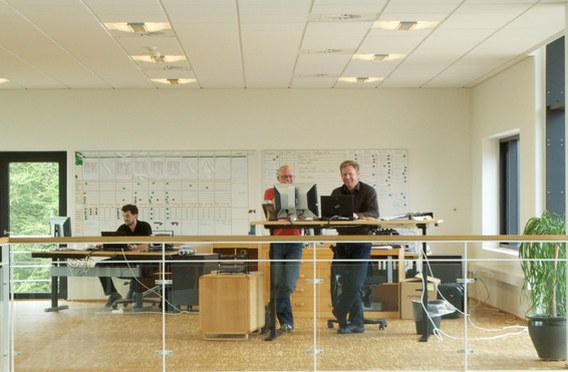
This has resulted in a change in office furnishings with fewer storage cabinets and an increase in technology, and also in a fundamental shift in task position, from predominantly horizontal documents to predominantly vertical display screens.
Additionally in many offices collaborative working is encouraged where formal or informal face-to-face discussions occur to consider short-term issues or long-term plans.
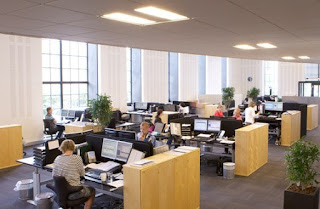
Building design has also developed as energy costs and sustainability issues gain importance, resulting in a high proportion of modern office space receiving significant levels of daylight.
Best practice
These changes impact all aspects of the design of modern office building services including artificial lighting. Lighting must be designed to prevent disturbing reflections on display screens, requiring a high level of optical control and technical competence in luminaire design. Lighting must also provide adequate illuminance to occupant’s faces, modelling features sympathetically and therefore allowing good visual as well as aural communication. This interplay of display screen versus human requirements needs careful planning of a lighting installation to produce a fulfilling space suitable for the task. Recommendations for lighting for DSE and also for modelling of faces and vertical surfaces are provided in the European Standard EN 12464-1:2011 Light and lighting – Lighting of work places Part 1: Indoor work places.
EN12464-1 provides recommended illuminance levels for a variety of office tasks. These illuminance values are task related and best practice is to layer the lighting levels, balancing the level on the task, the level on the surrounding area and the level on the background. It has been shown that the perception of how light or gloomy a space appears is based upon a 40° band in front of the viewer. This is generally the room walls and a portion of the ceiling. It is therefore important that room surfaces are lit to prevent a gloomy, oppressive ambience and EN 12464-1:2011 recommends an average illuminance of 75lx on the walls and 50lx on the ceiling.
Taking control
Supplying comfortable and effective light is not the same as supplying controlled and energy-efficient light. A lighting system should interact with the space, dimming in response to increasing levels of daylight, turning on or off in response to occupancy within the space, and with increasing use of technology, especially within meetings, allow lighting scenes to be set to provide the optimal conditions for the task at hand. Lighting should be an integral part of the office ambience, giving a calm or lively atmosphere dependant upon the needs of the task and space, providing a fulfilling workplace for people to enjoy and be stimulated in, benefiting both the individual and the business.
Call us today to discuss your office lighting needs, tel: 0208-540-8287, or email: sales@novelenergylighting.com. We supply a full range of LED panels, tubes, and downlights suited to office requirements. Visit us at www.novelenergylighting.com to explore our range of Thorn LED products.
led 1200x300 · led 1200x600 · led 600x600 · LED downlights · led panels · led tubes · Novel Energy Lighting · office led · office lighting · thorn led · thorn lighting
<< Latest posts
Older posts >>









